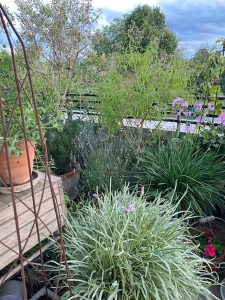Friday 16th June 9.16am and I will shortly be on my way through the South London streets to have coffee with a younger friend. Meanwhile I have been dead-heading and shuffling pots around on the balcony – greatest effort and attention being to rotate a dwarf eucalyptus, in ‘lollipop’ form, so that we will have more benefit from the shelter it provides and be able to enjoy looking at the beautiful glaucous leaves close at hand. Like all the plants on this south facing site the eucalyptus has been growing towards the sun leaving only the bare skeleton in clear view.
The Passage of Time
I always enjoy showing friends the balcony – it doesn’t take long and I usually learn something new about some of the plants I’m showing off. At the height of the Summer, as the leaves and flowers tumble out of the pots further reducing usable space for moving around, in truth if three or four are gathered together it’s more of an intimate huddle than a stroll around. And it’s deceptive as the plants that are happy are very happy and the failures of yesteryear are easily forgotten as pots can be replanted or stacked up out of sight.
 The standard olives continue to flourish, gaura is in flower, as is the lemon verbena (the oldest a woody specimen four foot high with flower spikes loved by visiting insects) and I’m beginning to spot the spikes of the dropmore purple (lythrum virgatum) coming into flower, which I read is a ‘spectacularly colourful plant for watersides, pond banks and woodland borders where the soil is reliable moist’. Like the pretty thalictrum delavayi, whose origins lies in the meadow rues of damp water margins, these pretty purple flowers spread around and self seed across the balcony not-withstanding the intermittent watering and scorching heat. Even in very small spaces horticultural surprises are possible.
The standard olives continue to flourish, gaura is in flower, as is the lemon verbena (the oldest a woody specimen four foot high with flower spikes loved by visiting insects) and I’m beginning to spot the spikes of the dropmore purple (lythrum virgatum) coming into flower, which I read is a ‘spectacularly colourful plant for watersides, pond banks and woodland borders where the soil is reliable moist’. Like the pretty thalictrum delavayi, whose origins lies in the meadow rues of damp water margins, these pretty purple flowers spread around and self seed across the balcony not-withstanding the intermittent watering and scorching heat. Even in very small spaces horticultural surprises are possible.
 If you are a member of the RHS you may have seen the article ‘Summer in the City’, in the July edition of ‘The Garden’ magazine, featuring balconies, rooftops and courtyards which have been turned into lush urban oases. They are all much grander, more spacious and carefully considered spaces than my over-crowded, and occasionally oppressive, tiny, tiled plot. But nevertheless there are often good ideas to pinch and hints to follow; clearly installing a sunken trampoline is never going to work on our roof top space, and I feel lucky to have one seated area aloft, let alone two, which with the addition of some comfy cushions, and shaded from the sun, is indeed heavenly.* But what all these spaces share, ours included, is an emphasis on all year round interest and the importance of the view looking out and across the borrowed views, whether of neighbours’ tall trees or the city edge beyond. I also try to have a few strategically placed plants to soften the view of the newer glass-sided school next door which has flat roof spaces but sadly no roof gardens as yet.
If you are a member of the RHS you may have seen the article ‘Summer in the City’, in the July edition of ‘The Garden’ magazine, featuring balconies, rooftops and courtyards which have been turned into lush urban oases. They are all much grander, more spacious and carefully considered spaces than my over-crowded, and occasionally oppressive, tiny, tiled plot. But nevertheless there are often good ideas to pinch and hints to follow; clearly installing a sunken trampoline is never going to work on our roof top space, and I feel lucky to have one seated area aloft, let alone two, which with the addition of some comfy cushions, and shaded from the sun, is indeed heavenly.* But what all these spaces share, ours included, is an emphasis on all year round interest and the importance of the view looking out and across the borrowed views, whether of neighbours’ tall trees or the city edge beyond. I also try to have a few strategically placed plants to soften the view of the newer glass-sided school next door which has flat roof spaces but sadly no roof gardens as yet.
*I have learnt from experience that when the parasol is open, it is best to thread a piece of thin rope through the spokes and attach it securely to one of the arms of the bench. The base is rooted to the ground but the risk of the canopy taking off is quite high, so a certain amount of ingenuity is required to ensure our outdoor space is reasonably functional as well as a secluded destination in which to linger amongst the sights and scents close at hand. All this appeals to me somewhat but I have been critised for being more interested in dead-heading the roses within reach of the bench, rather than concentrating on precious moments over coffee to catch up and plan for the day.
Moreover, if you are interested in city views, and have time to spare, a pre-planned visit to the ‘Walkie-Talkie’ building in Fenchurch Street, in the City of London, is well worth considering. Tickets are free but required, the security checks a reminder of travels further afield as conveyor belts and scanners have to be negotiated, and the gardens on the top three storeys of the 35 storey building are somewhat over-hyped I would argue. But the opportunity to view London, as far as the city edge and the green belt, as you take in the sensational 360 degree views from different perspectives, is one that will stay in my mind for a very long time – with the bonus that you also have a very good view of other roof-top gardens on lower buildings as well as the tree-lined streets and green spaces and squares down below.
There is also a chance to look at the Thames winding its path out to the sea. If you enjoy watching the world go by, you can also observe the pleasantly hypnotic, but complicated navigation of passengers and goods up and down the water. I became absorbed in the slow progress of a barge loaded with aggregate, perhaps heading for the building works at Craven Cottage (Fulham Palace’s football ground) which apparently have been undertaken with a pledge to bring in materials by water rather than add further distress to the road system in South West London.
Scents in the City
Sunday 25th June 6.26am and I wake up to a perfect Summer morning. Already the southerly breeze has filled the south facing bedroom with the scents from the balcony – certainly salvias, possibly lavender (much happier this year after following the advice last year on the comments’ section about caring for lavender plants) and I think there is still a lingering but dwindling contribution from the roses. For a few fleeting moments time, before the day creeps in, it’s possible to feel that all’s right in the world.
 The balcony is an enviable experimental garden, with beauty and bees aplenty but I’m no stranger at this time of year to envious longings for the greener grass the other side of the fence, to be found in the larger, less windy, green spaces around.
The balcony is an enviable experimental garden, with beauty and bees aplenty but I’m no stranger at this time of year to envious longings for the greener grass the other side of the fence, to be found in the larger, less windy, green spaces around.
It’s also quite sobering to be faced with the delights (I think of eating outside with friends, enough space to plant a newly discovered rose, the chance to wander at will enveloped by greenery or planning a new bed or border) that a bigger outdoor space would offer – but open views with space all around was our choice and continues to be our pleasure.
Saturday 15th July 11.30am and I’m driven back by the 40mph gusts that have devastated the balcony sending pots and plants flying. Down the road the Wimbledon women’s lawn tennis final will be held under the roof because of the ferocious winds, and having watered all the plants within reach of the windows (from the relative calm of the bedrooms) I too take cover and resist the urge to bring some order to the balcony. However, a heavy thud which can only mean another plant has been blown over, in time means I need to take action.
A week or two later and a slow, wet journey back from the West Country is accompanied by fleeting anxieties about the state of the plants on the balcony. House-plants, too, evoke a certain amount of concern but replacing house plants can be quite fun and my attachment to any particular plant isn’t nearly as strong as my deep attachment to some of the long-standing plants outside.
Such is the high level of anticipatory anxiety, and the potential for disappointment, that preparing for time away starts some time ahead – how long to go away and which time of year to least disadvantage both the allotment and the balcony? Kind neighbours and others have stepped in over the years but over or under watering is a risk and I’m fussy. So on the whole lengthy Summer holidays are best avoided and trips further afield are carefully scheduled. I also realised somewhat late in the day that the new requirements for renewing passports, or rather the new requirements to have time in hand before your passport expires, means planning ahead on all fronts before travelling to other European countries, so no bad thing.
 Meanwhile back to the issue of plant care while away. My tried and tested method is to move as many plants as possible into the centre of the balcony so increasing the possibility of catching any passing rain. Huddling together avoids evaporation too. I then give everything a good soak. I used to do something similar with house plants, leaving them in the bath on a very wet towel, having watered (or overwatered) each plant but the success rate wasn’t very high and these days I rely on house plants considerable capacity to recover if you can bear the time it might take, or find a replacement if all else fails.
Meanwhile back to the issue of plant care while away. My tried and tested method is to move as many plants as possible into the centre of the balcony so increasing the possibility of catching any passing rain. Huddling together avoids evaporation too. I then give everything a good soak. I used to do something similar with house plants, leaving them in the bath on a very wet towel, having watered (or overwatered) each plant but the success rate wasn’t very high and these days I rely on house plants considerable capacity to recover if you can bear the time it might take, or find a replacement if all else fails.
It’s difficult to know the beneficial tipping point between shopping to support local nurseries and increasing the carbon footprint of the balcony, already quite high as container grown plants often have a shorter life-span than plants growing in the ground. But the bees and other pollinators are still visiting aloft in good numbers and the plants deflect the heat of the sun away from the external walls.
Sunday 13th August 1.38pm or 13.38 for those who think in terms of the 24 hour clock. Would the one o’clock news on Radio 4 keep it’s ratings if it was to be known as the 13.00 news on Radio 4?
The last few weeks has seen a succession of high temperatures and high rainfall all accompanied by high winds. It’s disheartening when it comes to gardening aloft as the sound of large containers crashing into other planters is one to try and avoid at all costs.
 With that thought in mind I recently wedged a tall container between a bench, wall and other containers, and mounted it on a three-wheeled pot stand for ease of moving it aside when access was needed. It turns out that the large container was lighter than it might have been as the battle to keep everything well watered in spite of the wind was one I had already lost. The pot stand somehow got caught by the wind it such a way that it revolved in ever more urgent ways until it had thrown off the pot itself which crashed onto the smaller planters underneath but fortunately didn’t itself come to much harm or do lasting damage.
With that thought in mind I recently wedged a tall container between a bench, wall and other containers, and mounted it on a three-wheeled pot stand for ease of moving it aside when access was needed. It turns out that the large container was lighter than it might have been as the battle to keep everything well watered in spite of the wind was one I had already lost. The pot stand somehow got caught by the wind it such a way that it revolved in ever more urgent ways until it had thrown off the pot itself which crashed onto the smaller planters underneath but fortunately didn’t itself come to much harm or do lasting damage.
I have jettisoned the pot stand.
and finally……….
Given the destructive part wind and weather has played in so many global tragedies, or heartache closer to home, my mostly manageable challenges are of course on a comparatively minuscule scale. However, after three years of planting without the protection of the row of elderly, now deceased tall trees alongside, some further adjustments might be needed next year. This may be a frustrating and somewhat futile endeavour, along the lines of rearranging the deck-chairs on the Titanic, but I am sure I will learn a lot along the way and in time, hopefully, have a bit more wind protection for the smaller plants and the wind-sensitive parasol.
In the meantime, the olives continue to grow, produce fruit and flourish, the pomegranate (see photo) has also flourished undeterred by a few wind-scorched leaves and the scabious, thulbaghia and salvias continue to look lovely intermingling with the overgrown lemon verbena (a favourite) which will continue to attract bees and other insects well into the shorter days. But two months can be a very long time in the life of a plant and the ‘lollipop’ eucalyptus has gone. The already stressed and pot bound plant having eventually succumbed to the vagaries of the weather.
However the roses, which unlike the eucalyptus are unphased by the weather, do look particularly beautiful at this time of year – less blowsy, with petals that quickly become papery and little fragrance, but a delight and as the star jasmine (trachelospermum jasminoides) has put on a lot of growth over the Summer it will be commandeered as a first contribution to the revised wind break.
My mother used to reassure me, particularly at Christmas time, that the best things often came in small parcels, which at the time I never found entirely convincing, but now I count myself lucky indeed to have a small patch, under the skies, to call my own.







Is this a hint that Fulham and Crystal Palace are going to merge?
Thank you for pointing out that I should of course have written Fulham’s football ground. There are no excuses for getting confused as Crystal Palace mast is clearly visible from the balcony from Autumn onwards when the leaves are not obscuring the view, and I frequently travel up Fulham Palace Road to the garden centre of that name. I have never been to watch a Fulham match (or indeed a match at Crystal Palace) but clearly they have somehow become merged in my mind if not in reality.
Thanks again for pointing out my muddle.
Thank you for the “walkie talkie” tip. We might try and do that next week!
Enjoy!
Dear Ann
From my damp and leaf-laden suburban oblong of ‘managed re-wilding’, greetings! As always good to visualise your tree-top ‘plot’. I managed to beat the rain and mowed part of the grass last night which offsets the wilder fringes/verges and the orchardy bit at the back with its quince and apple trees. I spotted the first of the wild cyclamen there yesterday, and the Blenheim orange apple has begun to drop its smaller green fruit in favour the ones plumping up with the rain. It’s a late cropper – it is supposed to develop orangey skin – if only there was more sun.
I’ve never written much about my gardening exploits, and it feels quite strange to do so. Like your balcony, deluges and high winds here have been a dominant factor for the past 7 weeks, and dictate what to do and when. I must stop and send love and good gardening wishes!
Thank you so much for your wonderfully evocative picture of late Summer’s arrival in your garden. I did find myself pining for grass underfoot with all it’s accompanying treasures, but it is also very comforting and encouraging to be in touch with friends and fellow gardeners who both in their own individual green spaces, and hopefully too through providing a small link in a somewhat fragmented chain, contribute to the green corridors all our cities desperately need. Thank you again
Hi Anne, I am sure that you are relieved each week that in your Sky Garden you don’t have to wonder if you ought to cut the grass!! Well, this year we have taken the RHS advice and allowed half of our lawn to become a meadow and not bothered to keep the other half short, That was good advice and will be followed next year. Of course when the meadow eventually needed to be cut it was hard work and no hay was gathered. Yes the Walkie Talkie Sky Garden is an exciting place, so much so that we are having a family party lunch there in September.
Enjoy your family gathering at the Sky Garden! Meanwhile your comment prompted me to have another look at the distant views from our balcony which are now becoming more far reaching as the leaves on the nearby tall trees begin to shrivel and will soon start to drop. A lot depends too on how the light falls but at the moment the predominantly white buildings of St Helier Hospital, Carshalton, are clearly visible with the tree-covered Surrey Hills in view behind. But unlike the Sky Garden our views northwards are largely obscured by buildings old and new, although we can just see Canary Wharf but not the City of London and the ‘Walkie Talkie’.
I‘m reading this in Brittany where like elsewhere in France and much of the U.K it‘s very hot and dry and I see London is forecast to get to 31 degrees today. After reading about your planning for plant care whilst away I’m wondering if you are in Provence. I seem to remember you mentioned you were planning to go. I hope the balcony plants survive.
Thank you for your comment and for thinking about my balcony. The high heat has passed but no rain yet in South West London. Instead of Provence, which will have to wait for another time, we have been briefly back to Cornwall. Driving across the South of England along the traditional route to the sun (the A303) in late Summer, and back again, is for me always somewhat poignant with all the associations and reminders of shorter days ahead and of Summers long gone. However, the balcony benefitted from the revised travel plans as I was able to keep up with the watering, but many thanks for your concern.
My top tip for anyone wondering about more unusual plants that might cope with erratic high temperatures and high winds, as well as intermittent watering, might be to buy a pomegranate suitable for English conditions. Mine has grown rapidly over the Summer, so much so that I felt I should learn how to prune it (late Winter once the frost have gone) to improve the chance of fruit one day. I will keep you posted.